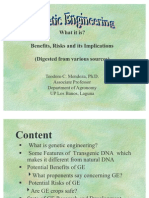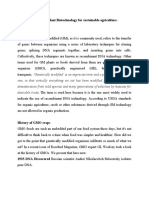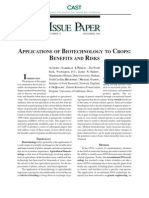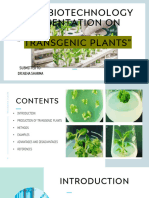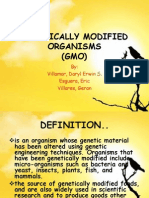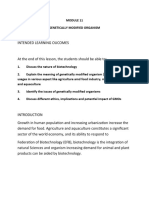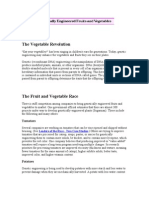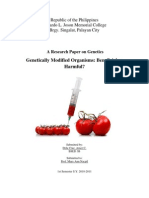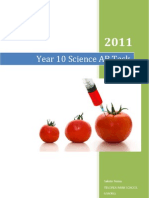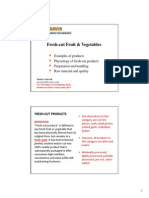Biotechnology and Postharvest Quality
Biotechnology and Postharvest Quality
Uploaded by
BalapekCopyright:
Available Formats
Biotechnology and Postharvest Quality
Biotechnology and Postharvest Quality
Uploaded by
BalapekOriginal Description:
Original Title
Copyright
Available Formats
Share this document
Did you find this document useful?
Is this content inappropriate?
Copyright:
Available Formats
Biotechnology and Postharvest Quality
Biotechnology and Postharvest Quality
Uploaded by
BalapekCopyright:
Available Formats
Biotechnology and Postharvest
Quality
Diane M Beckles
Department of Plant Sciences
University of California-Davis
dmbeckles@ucdavis.edu
http://www.plantsciences.ucdavis.edu/beckles/beckles_index.html
Biotechnology
A set of tools (molecular) used to modify the
genetic makeup of an organism so that:
It produces a new product
The product perform new function(s)
Postharvest Quality
The factors that ensure maximum income for
producers as well as meeting the nutritional and
aesthetic needs of the consumer after horticultural
crops are harvested.
Producers and consumers often have opposing wants
Consumers
Textur
e
Flavour
Aroma
Sweetness
Acidity
Color
Appearance
Nutrition
Producers
Shelf-life
Chilling-
tolerance
Microbial
contamination Browning
Firmness
Disease
resistance
Genotype
The genetic composition of an organism.
Contains all of the information that
determines final characteristics.
Postharvest traits are due to the interaction
of the environment and genotype
Identical genotype
Different environment
Different genotype
Same environment
Normal
tomato
rin: ripening
mutant
25C
Ripened fruit
Chilling injury
25C
5C
Normal
tomato
Biotechnology can be used to change the gene
composition and create genetically engineered
organisms (GEOs) with enhanced traits -
including those with improved postharvest
qualities.
Power of biotechnology
Desirable traits for improving Postharvest
Quality of produce
Improved flavour, texture, colour
Long storage
Delayed ripening
Enhanced nutrition and health benefits
Better food processing
Nutraceuticals
MYTH: Genetic modification of crop plants
is new
False: All crop plants have been
genetically modified
Biotechnology is another (more sophisticated)
tool used to genetically modify crop plants
Domestication
Science-based Selective breeding
Mutagenesis breeding
Embryo culture
Biotechnology and genetic
engineering
Sophistication of technology
Genetic modification of crop plants
1. Domestication.
2. Selective breeding.
3. Mutagenesis breeding.
4. Embryo culture.
5. Biotechnology.
Domestication: cultivated vs wild tomato
Wild Modern cultivated
tomato tomato
From Frary et al., 2000 Science
Wild banana vs modern cultivars
Wild banana with seeds Cultivated banana- sterile
Genetic modification of crop plants
1. Domestication
2. Selective breeding
3. Mutagenesis breeding
4. Embryo culture
5. Biotechnology
2. Selective breeding
Solanum
lycopersicon
Solanum
peruvianum
Wild species has
resistance to
nematodes
Percent of wild genes 50%
25%
12.5%
Using the wild tomato
species as a source of genes
for nematode resistance
Six or more generations of
backcrosses to the culti vated
parent, selecting for
resistance at each generation
6.25%
3.125%
1.5%
0.75%
Kent Bradford, Depart Plant Sciences, UC Davis
Selective breeding
Cauliflower and broccoli were derived from the same genetic ancestor
Brassica oleracea
California Agriculture vol 58 #2; http://CaliforniaAgriculture.ucop.edu
Genetic diversity
From : What is Biotechnology? by Dr. Peggy Lemeaux; University of California, Berkeley
Genetic modification of crop plants
1. Domestication
2. Selective breeding
3. Mutagenesis breeding
4. Embryo culture
5. Biotechnology
3. Mutational breeding
Radiation breeding: Texas red grapefruit variety Rio Red
Developed by mutation of Ruby Red. There are more than 2000
Crops which were produced by radiation
Chrispeels and Sadava, 2002 Plant, Genes and Crop Biotechnology; ASPB
Genetic modification of crop plants
1. Domestication
2. Selective breeding
3. Mutagenesis breeding
4. Embryo culture
5. Biotechnology
4. Embryo rescue-
laboratory culture of plant embryos
Inter-species crossing
Embryo cannot naturally develop into a mature plant
Embryo must be dissected and nurtured on media
Fruits cultivated by embryo rescue
Early-ripening stone fruit
varieties
All seedless grape varieties
Small immature embryos
that must be cultured
individually in test tubes to
grow a hybrid seedling.
Genetic modification of crop plants
1. Domestication
2. Selective breeding
3. Mutagenesis breeding
4. Embryo culture
5. Biotechnology
5. Biotechnology
Manipulations done at molecular level.
Specific genes may be changed.
Gene function usually understood.
Genes can be transferred between species.
Tenets
All living organisms characteristics determined by
DNA.
DNA code broken functions known for most DNA
sequences.
DNA is fundamentally the same in all organisms
DNA should be interchangeable between species.
Gene identification
Genes encoding important traits
Extended shelf-life
Insect, disease resistance
Uniform ripening
Increased sugars
Enhanced Aroma
Antioxidants
Gene manipulation
Gene expression in crop is altered in various ways
Suppression (a deleterious gene)
Over-expression (favourable gene)
Modification (enhancing a characteristic)
Transgene expression (introducing new function)
How genetic engineering of plants works
A gene of known function in plant is identified (e.g.
gene controlling fruit ripening) and isolated.
The gene must be stably incorporated into plant.
The gene must be heritable.
Genes are introduced into the plant using
bacterial plasmid as vectors
Gene to be suppressed or overexpressed
Plasmids are circular molecules of DNA found in bacterial cells. They confer survival to antibiotics
How to get the DNA into the plant
Agrobacteriumtumesfaciens (more precise).
Particle bombardment (random insertion of genes).
Regeneration from single cell to whole plant
drawing by CelesteRusconi, Regents of theUniv. California
Biotechnology & Postharvest biology
Can we use these tools to improve the postharvest
quality of horticultural crops?
Adel Kader, Dept Plant Sciences, UC Davis
Yes..maybe
Transgenic papaya resistant to papaya
ringspot virus
California Agriculture vol 58 #2; http://CaliforniaAgriculture.ucop.edu
Non-transgenic Transgenic
Transgenic plums resistant to plum pox virus
Non-transgenic fruit Transgenic fruit
California Agriculture vol 58 #2; http://CaliforniaAgriculture.ucop.edu
Novel ornamentals
Florigene Moonshadow
transgenic carnations;
produces intense blue-
violet colour.
Flavr Savr tomatoes extended shelf-life
Chrispeels & Sadava, 2002 Plant, Genes and Crop Biotechnology; ASPB
Uniform/delayed ripening
Transgenic tomatoes with
altered ethylene production.
Harvest can be done every 2
days instead of twice a day.
Fruit stays in field longer
without deteriorating.
Non-transgenic Transgenic fruit
4-colours 2-colours
From : What is Biotechnology? by Dr. Peggy Lemeaux; University of California, Berkeley
Delayed softening/ripening in transgenic
apples
Dandekar et al (2004) Transgenic Research 13 373-384
Transgenic
Transgenic
Transgenic
Control
Whats the problem with GE?
Polarizing and disparate views of
the technology
GE crops harmful to living creatures?
Drawing by Nicholas Eattock, Dept Plant Sciences UC Davis
GE crops will create monsters
Drawing by Nicholas Eattock, Dept Plant Sciences UC Davis
GE crops a cure-all
Drawing by Nicholas Eattock, Dept Plant Sciences UC Davis
GE crops - bountiful harvests
Drawing by Nicholas Eattock, Dept Plant Sciences UC Davis
Public perception of GE
FACTOR
Coerced vs. voluntary
Industrial vs. natural
Dreaded vs. not dreaded
Unknowable vs. knowable
Untrustworthy rather than
trustworthy
Unresponsive vs. responsive
management
EXAMPLE
Everyone must eat GE food if
unlabeled.
Big multinational hybrid vs. landraces.
Unknown risks (cancer?)
Only experts know the risk, and they
debate
Multinational vs. small farmer
Open vs. arrogant and remote
Chrispeels and Sadava, 2002 Plant, Genes and Crop Biotechnology; ASPB
Getting to the truth about GE crops
Facts vs fiction about GE crops
Myth GE plants will create superweeds.
FactGE plants will create weeds just like most
crop plants; cannot determine the impact
on the environment.
Facts vs fiction about GE crops
MYTH GE foods have genes and normal
food do not.
FACT All living organisms have genes.
Facts vs fiction about GE crops
MYTH Almost all crops are GE.
FACT The cost of meeting regulatory
requirements ($20-30 million per crop)
limits the number of GE crops
commercialized. This
is especially true of
horticultural crops (only 2-3 exist).
Facts vs fiction about GE crops
MYTH There will be animal genes in fruit
and vegetables.
FACT Technically possible to accomplish this
..but no company would commercialize
a product which would be reviled by
the consumer bad business!
Facts vs fiction about GE crops
MYTH GE food are unnatural.
FACT So are all of the foods (including
fruit and vegetables we eat
today!).
Facts vs fiction about GE crops
MYTH When you transform plants you do
not know what is happening.
FACT With transgenics you introduce a
single gene, with traditional
breeding you may introduce hundreds
of unknown genes.
Genetic re-arrangement in selective cross
breeding vs GE
1. Whats for dinner Genetic engineering from the lab to your
plate.
2. Gepts, P. (2002) Crop Science 42:1780-1790
Facts vs fiction about GE crops
MYTH Farmers in developing countries will
not benefit.
FACT Governments of many developing
countries have adopted technology
pioneered by multinationals.
http://www.fao.org/biotech/inventory_admin/dep/default.asp
Facts vs fiction about GE crops
MYTH GE food will contain allergens and
toxins
FACT (i) We consume 10,000 toxins daily.
Coffee contains 1000 toxins, of
27 tested 19 were carcinogens.
(ii) Peanuts, brazil nuts, wheat cause
serious allergic reactions
Facts vs fiction about GE crops
MYTH Transgenes will move from plants to
humans once ingested
FACT No-one has shown that genes
move from ingested food into
human cells
Facts vs fiction about GE crops
MYTH GE crops are not adequately tested
or regulated
FACT There are greater testing requirements for
GE crops compared to traditional crops
http://usbiotechreg.nbii.gov/lawsregsguidance.asp
Substantial Equivalence
Numerous scientific reviews have concluded that food
created by genetic engineering presents no greater
dangers than genetic changes introduced by other
methods.
The product should be evaluated, not the method by
which it is produced.
Bradford et al., (2005) Nature Biotechnology 23: 439-444
Limits to application of biotechnology to
Horticultural crops
Economies of scale.
Expensive to apply to niche crops and cultivars
Technologies not sufficiently developed for
individual crops.
Long generation times - not tractable.
For tree crops use grafting!
Transgenic walnut shoot grafted onto
control rootstock in B while crowngall
develops in non-transgenic shoot graft
A
Escobar et al (2001) Proc Natl Acad Sci USA. 98:42
Limits to application of biotechnology to
Horticultural crops
Several postharvest traits are complex
Multigenic; strongly affected by the environment
Public resistance to the idea.
More intimate association with fruit and
vegetables than maize or soybean products
Gene transfer to non-GE crops.
Disturbing evidence that native landraces in Mexico
pollinated by GE crops*
Positional Effects.
Disruption of native genes at the site where the construct
is inserted**
Monopolization/Concentration power by seed
companies
They determine the traits worthy of investment.
Humanitarian interests may not be prioritized.
Unresolved Issues
*http://www.plantsciences.ucdavis.edu/gepts/mec_3993_LOW.pdf
**Gepts, P. (2002) Crop Science 42:1780-1790
Real risks of common activities from actuary
data
Number of deaths divided by number of people engaged in the activity from
Chrispeels & Sadava, 2002 Plant, Genes and Crop Biotechnology; ASPB
Summary
Biotechnology holds great potential for improving
postharvest biology of horticultural crops
No technology is risk-free or is absolutely safe
Genetic modification of crops is not new
Today we have better, more sophisticated tools to
achieve crop improvement
Scientists must adequately address food and
environmental risks as well as public concerns about
the technology
Bibliography/Sources
Chrispeels and Sadava, 2002 Plant, Genes and Crop Biotechnology; ASPB
Bradford KJ & Alston, J . (2004) California Agriculture vol 58(2):84-85
http://CaliforniaAgriculture.ucop.edu
Bradford et al (2004) California Agriculture 58(2):68-71
http://CaliforniaAgriculture.ucop.edu
Clark et al (2004) California Agriculture 58(2): 89-98
http://CaliforniaAgriculture.ucop.edu
Lemaux, P. (1998) What is biotechnology?
http://ucbiotech.org/resources/biotech/slides/biotech.html retrieved 5/20/03
Whats for dinner Genetic engineering from the lab to your plate.
http://www.foodsafetynetwork.ca/biotechres/newpdfs/pg9-18.pdf retrieved
5/20/03
Prakash C.S. : Agricultural Biotechnology and Food Security
www.agbioworld.org retrieved 5/20/03
Bibliography/Sources (contd)
Bradford et al., (2005) Nature Biotechnology 23: 439-444
Dandekar et al (2004) Transgenic Research 13: 373-384.
Frary et al. (2000) Science 289. no. 5476, pp. 85-88
Introduction to Genetic Analysis Anthony Griffiths 9th Ed (2008). W.H.Freeman
Publishers
Gepts, P. (2002) Crop Science 42:1780-1790
US Regulatory Agencies Unified Biotechnology website
http://usbiotechreg.nbii.gov/lawsregsguidance.asp
Cartoons by Nicholas J . Eattock, Dept Plant Sciences, UC Davis
You might also like
- Ap Biology Lab ManualDocument426 pagesAp Biology Lab Manualapi-259780711No ratings yet
- 2022 BBO Paper1: Part 1 of 1Document26 pages2022 BBO Paper1: Part 1 of 1Z Albert0% (1)
- Genetic EngineeringDocument45 pagesGenetic EngineeringKathleen Joy BitaoNo ratings yet
- Biotech MJDocument26 pagesBiotech MJXiao LhieNo ratings yet
- Clinical Review: Science, Medicine, and The FutureDocument4 pagesClinical Review: Science, Medicine, and The FuturemaryvemaxNo ratings yet
- 9-GMO FemDocument24 pages9-GMO FemClarisse DiconNo ratings yet
- Pros and Cons GenesDocument47 pagesPros and Cons GenesEsheikell ChenNo ratings yet
- Plant BiotechnologyDocument17 pagesPlant BiotechnologyROMEL A. ESPONILLA100% (1)
- Plant BT AssignmentDocument7 pagesPlant BT AssignmentDevanjan ChakravartyNo ratings yet
- Plant Biotech AssignmentDocument7 pagesPlant Biotech AssignmentDevanjan ChakravartyNo ratings yet
- What Is Selective ReproductionDocument7 pagesWhat Is Selective Reproductionmrcesar19No ratings yet
- Genetic EngineeringDocument6 pagesGenetic EngineeringMARIA TARIQNo ratings yet
- Gmo Vs Selective BreedingDocument9 pagesGmo Vs Selective Breedingapi-267067429No ratings yet
- BIOTECHNOLOGYDocument62 pagesBIOTECHNOLOGYTheMoneyMitraNo ratings yet
- Bio Project TokaDocument29 pagesBio Project TokaToka Mohamed ElSayedRadwanNo ratings yet
- q5 BiotechDocument7 pagesq5 BiotechAnushka DhandeNo ratings yet
- Application of Plant Biotechnology For Sustainable AgricultureDocument18 pagesApplication of Plant Biotechnology For Sustainable AgriculturelkokodkodNo ratings yet
- Genetically Modified OrganismsDocument4 pagesGenetically Modified OrganismsAlyza FateNo ratings yet
- A B C: B R: Pplications OF Iotechnology TO Rops Enefits AND IsksDocument8 pagesA B C: B R: Pplications OF Iotechnology TO Rops Enefits AND IsksEnkhbaatar BatmagnaiNo ratings yet
- Group 4Document35 pagesGroup 4Princessjoy Campos BarreraNo ratings yet
- GROUP 5 Genetically Modified OrganismsDocument34 pagesGROUP 5 Genetically Modified OrganismsHaire Raiza MohammadNo ratings yet
- Shreya Jindal PPT 2Document13 pagesShreya Jindal PPT 2Shreya JindalNo ratings yet
- GMO and Evolution TokaDocument28 pagesGMO and Evolution TokaToka Mohamed ElSayedRadwanNo ratings yet
- What Is genetic-WPS OfficeDocument16 pagesWhat Is genetic-WPS OfficeShamoon HaroonNo ratings yet
- GMO Assignment TermpaperDocument18 pagesGMO Assignment TermpaperHajar IsahNo ratings yet
- Genetically Modified OrganismsDocument17 pagesGenetically Modified OrganismsBosz ChiqletNo ratings yet
- Earth and Life Science NotesDocument3 pagesEarth and Life Science Notesradz quilinganNo ratings yet
- Charecters of Transgenic Plants: 1. Improved Nutritional QualityDocument5 pagesCharecters of Transgenic Plants: 1. Improved Nutritional Qualityammayi9845_930467904No ratings yet
- LEC2 - Genetic Engineering and Genetically Modified OrganismsDocument40 pagesLEC2 - Genetic Engineering and Genetically Modified OrganismsBea BalungayaNo ratings yet
- Transgenic Plants: Varshitha B.N. 2 Year M.Sc. DOS in Biotechnology Manasagangothri, MysuruDocument49 pagesTransgenic Plants: Varshitha B.N. 2 Year M.Sc. DOS in Biotechnology Manasagangothri, MysuruVarsha MouniNo ratings yet
- Agricultural Biotechnology - WikipediaDocument23 pagesAgricultural Biotechnology - WikipediaAdeyemo DamilolaNo ratings yet
- DocumentDocument8 pagesDocumentDebjyoti MandalNo ratings yet
- Plants: Plant Breeding Is The Science of Changing The Traits ofDocument20 pagesPlants: Plant Breeding Is The Science of Changing The Traits ofBharat PatelNo ratings yet
- Module 5 Lesson 11Document6 pagesModule 5 Lesson 11John eric CatayongNo ratings yet
- Applications of Bioinformatics in AgricultureDocument7 pagesApplications of Bioinformatics in AgricultureNivetha Nagarajan50% (2)
- Producing GeneticallyModified OrganismsDocument9 pagesProducing GeneticallyModified Organismskhate lisabaNo ratings yet
- 1 What Is A GmoDocument22 pages1 What Is A GmoPinaring BreederNo ratings yet
- What Is Genetic EngineeringDocument18 pagesWhat Is Genetic EngineeringnniizzaaNo ratings yet
- Term Paper ON: Transgenic PlantsDocument17 pagesTerm Paper ON: Transgenic PlantsVikal RajputNo ratings yet
- Module 11 Genetically Modified OrganismDocument24 pagesModule 11 Genetically Modified OrganismCharles CabarlesNo ratings yet
- Genetic EngineeringDocument42 pagesGenetic EngineeringPraveena R. JaiswalNo ratings yet
- Genetically Modified Organisms515Document6 pagesGenetically Modified Organisms515Irvin OngyacoNo ratings yet
- Genetically Modified FoodsDocument20 pagesGenetically Modified FoodssyafikahainunNo ratings yet
- Bio (Ma)Document18 pagesBio (Ma)Shrigith SNo ratings yet
- Agro 202Document9 pagesAgro 202Annabelle AgustinNo ratings yet
- Transgenic Crops or Genetically Modified Organisms GMODocument6 pagesTransgenic Crops or Genetically Modified Organisms GMOAyaz Latif SiyalNo ratings yet
- Lecture 2 HPRDocument4 pagesLecture 2 HPRhasu9749No ratings yet
- What Is A GMO?Document2 pagesWhat Is A GMO?Gweninay SolimanNo ratings yet
- GMO Technology Is Simply Precision BreedingDocument3 pagesGMO Technology Is Simply Precision Breedingkevinfolta100% (4)
- A Review On Impacts of Genetically Modified Food On Human HealthDocument9 pagesA Review On Impacts of Genetically Modified Food On Human HealthMi band 4 İqbalNo ratings yet
- Peter 2011Document9 pagesPeter 2011Muhammad Tubagus HanafiNo ratings yet
- Genetically-Modified OrganismsDocument51 pagesGenetically-Modified OrganismsAiza Mae SeguerraNo ratings yet
- The Vegetable Revolution PraDocument5 pagesThe Vegetable Revolution PraaxxoripsNo ratings yet
- Genetically Modified Organisms: Beneficial or Harmful?Document9 pagesGenetically Modified Organisms: Beneficial or Harmful?sweet_bhe2401No ratings yet
- Genetically Modified Organisms GMOsDocument20 pagesGenetically Modified Organisms GMOsNeptune LopezNo ratings yet
- LP 4 GmoDocument39 pagesLP 4 Gmokjohn09876543No ratings yet
- 1 What Is A GmoDocument12 pages1 What Is A Gmomeenakshi2402jhaNo ratings yet
- Year 10 Science AB Task: Salote Temu Telopea Park SchoolDocument5 pagesYear 10 Science AB Task: Salote Temu Telopea Park SchoolSalote Olive TemuNo ratings yet
- GMOSlaDocument3 pagesGMOSlaLouisse Angeli AbucejoNo ratings yet
- Master Gardener Newspaper Articles: Try Seeding A Special FlowerbedDocument2 pagesMaster Gardener Newspaper Articles: Try Seeding A Special FlowerbedBalapekNo ratings yet
- Mobile Milking Unit MMU SGDocument2 pagesMobile Milking Unit MMU SGBalapekNo ratings yet
- Micro-Hydro Power: Is It Right For My Farm?: A Project of The National Center For Appropriate TechnologyDocument8 pagesMicro-Hydro Power: Is It Right For My Farm?: A Project of The National Center For Appropriate TechnologyBalapekNo ratings yet
- Postharvest Handling of Some Specialty Fruits (Date, Fig, Olive, Pomegranate)Document8 pagesPostharvest Handling of Some Specialty Fruits (Date, Fig, Olive, Pomegranate)BalapekNo ratings yet
- Storing Fresh Fruits and Vegetables For Better TasteDocument2 pagesStoring Fresh Fruits and Vegetables For Better TasteBalapekNo ratings yet
- Fresh-Cut Fruit & VegetablesDocument27 pagesFresh-Cut Fruit & VegetablesBalapekNo ratings yet
- K.G.L.R. Jayathunge, W.M.C.B. Wasala, H.M.A.P. Rathnayake, C.R. Gunawardane, H.C. Samarakoon, M.D. Fernando and K.B. PalipaneDocument47 pagesK.G.L.R. Jayathunge, W.M.C.B. Wasala, H.M.A.P. Rathnayake, C.R. Gunawardane, H.C. Samarakoon, M.D. Fernando and K.B. PalipaneBalapekNo ratings yet
- The US Fresh Produce Value Chain The US Fresh Produce Value ChainDocument45 pagesThe US Fresh Produce Value Chain The US Fresh Produce Value ChainBalapekNo ratings yet
- Fruit Maturity, Ripening and Quality: Postharvest ParadoxDocument5 pagesFruit Maturity, Ripening and Quality: Postharvest ParadoxBalapekNo ratings yet
- Irradiation: of Fresh Fruits and VegetablesDocument8 pagesIrradiation: of Fresh Fruits and VegetablesBalapekNo ratings yet
- Tomatoes: Safe Methods To Store, Preserve, and Enjoy: PublicationDocument15 pagesTomatoes: Safe Methods To Store, Preserve, and Enjoy: PublicationBalapekNo ratings yet
- Safe Methods of Canning Vegetables: Publication 8072Document11 pagesSafe Methods of Canning Vegetables: Publication 8072BalapekNo ratings yet
- Postharvest Quality of Bing Cherries Following Preharvest Treatment With Hydrogen Cyanamide, Calcium Ammonium Nitrate, or Gibberellic AcidDocument5 pagesPostharvest Quality of Bing Cherries Following Preharvest Treatment With Hydrogen Cyanamide, Calcium Ammonium Nitrate, or Gibberellic AcidBalapekNo ratings yet
- Ozone Applications For Postharvest Disinfection of Edible Horticultural CropsDocument8 pagesOzone Applications For Postharvest Disinfection of Edible Horticultural CropsBalapekNo ratings yet
- Molecular Basis of Inheritance PyqDocument12 pagesMolecular Basis of Inheritance PyqSoumya Ranjan NaikNo ratings yet
- Gbio 2122 Week 11 20Document7 pagesGbio 2122 Week 11 20Piei CornerNo ratings yet
- 4455 Genetics Questions and AnswersDocument13 pages4455 Genetics Questions and Answersmikejose704No ratings yet
- NIH Public Access: Author ManuscriptDocument14 pagesNIH Public Access: Author Manuscript10sgNo ratings yet
- Gene Transfer in BacteriaDocument2 pagesGene Transfer in BacteriadaniellaNo ratings yet
- Literature Review On DnaDocument4 pagesLiterature Review On Dnaafmzydxcnojakg100% (1)
- Properties of LifeDocument4 pagesProperties of LifeAndy Bautista De LeonNo ratings yet
- Name: Võ Nhật Lê ID: BI11-141 Class: D1 Introduction to EnsemblDocument3 pagesName: Võ Nhật Lê ID: BI11-141 Class: D1 Introduction to EnsemblNL DearestNo ratings yet
- Flavr Savr TomatoDocument5 pagesFlavr Savr TomatoSanjeevani adhikariNo ratings yet
- CBSE Class 12 Biology 2019 Question Paper Solution Set 4Document14 pagesCBSE Class 12 Biology 2019 Question Paper Solution Set 4PavanNo ratings yet
- GCSE Biology Lesson PlanDocument37 pagesGCSE Biology Lesson Plancokbhatti100No ratings yet
- Biotec-401 First 7 Weeks (Till Mid)Document100 pagesBiotec-401 First 7 Weeks (Till Mid)Malik UsamaNo ratings yet
- Translation Dna To Mrna To ProteinDocument5 pagesTranslation Dna To Mrna To ProteinAna MarianaNo ratings yet
- Alok 12Document16 pagesAlok 12ChandrakanthNo ratings yet
- Ghaitsa Zahira - Annotating Text and ResumeDocument14 pagesGhaitsa Zahira - Annotating Text and ResumeGhaitsa Zahira SNo ratings yet
- CSIR NET Life Sciences June 2011 Question Paper Key PDFDocument47 pagesCSIR NET Life Sciences June 2011 Question Paper Key PDFAmrita NepaliaNo ratings yet
- Module 3 GEE 4Document22 pagesModule 3 GEE 4abegail arponNo ratings yet
- Biology Passing Material KAYAKA PU COLLEGE KALABURAGIDocument23 pagesBiology Passing Material KAYAKA PU COLLEGE KALABURAGIRAJAGOPAL93% (15)
- Foundation Course in Biology - Edited FinalDocument3 pagesFoundation Course in Biology - Edited Finalavani vankarNo ratings yet
- Lecture 1 2Document142 pagesLecture 1 2ngocnm.bi12-320No ratings yet
- The Benefits and Risks of Using GmosDocument41 pagesThe Benefits and Risks of Using GmosDanica TarapeNo ratings yet
- Gene Therapy: Science, Technology and SocietyDocument18 pagesGene Therapy: Science, Technology and SocietyTricia AcordaNo ratings yet
- Biology 1e PDFDocument1,480 pagesBiology 1e PDFSittie Haynah Moominah Bualan100% (1)
- Cambridge International ASa Level Biology Study and Revision GuideDocument252 pagesCambridge International ASa Level Biology Study and Revision GuidefelicehurleywijayaNo ratings yet
- 2020-21 T.Y.B.Sc Botany (C.B.C.S)Document49 pages2020-21 T.Y.B.Sc Botany (C.B.C.S)GIREESH DEORENo ratings yet
- ENZYME Guidance Final 6-29-10Document12 pagesENZYME Guidance Final 6-29-10Chinh Đinh ViệtNo ratings yet
- Advanced QTL BackcrossDocument13 pagesAdvanced QTL Backcrossrssandhu064No ratings yet
- L7S12. Central Dogma and Genetic Engineering - FDocument35 pagesL7S12. Central Dogma and Genetic Engineering - FSichayra GamotiaNo ratings yet


